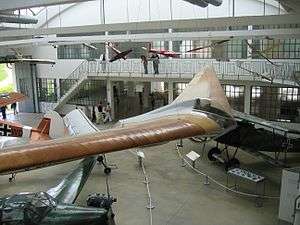Horten H.IV
| Horten H.IV | |
|---|---|
 | |
| Horten H.IV in the Deutsches Museum at Schleissheim, Munich | |
| Role | Glider |
| Manufacturer | Horten |
| Designer | Reimar and Walter Horten |
| Number built | 4 |
The Horten H.IV was a German tailless flying wing glider in which the pilot was to lie in a prone position to reduce the frontal area, and hence drag. It was designed by Reimar and Walter Horten in Göttingen. Four were built between 1941 and 1943. They were flown in a number of unofficial competitions in Germany during World War II. After the war the flying examples were transported to the United Kingdom and the United States where several contest successes were achieved.
Specifications
Data from [1]
General characteristics
- Crew: 1
- Length: 3.81 m (12 ft 6 in)
- Wingspan: 20.3 m (66 ft 7 in)
- Wing area: 18.9 m2 (203 sq ft)
- Aspect ratio: 21.8
- Empty weight: 250 kg (551 lb)
- Gross weight: 330 kg (728 lb)
- Airfoil thickness: 16% T/C ratio
- Sweepback at LE: 20 degrees
Performance
- Never exceed speed: 200 km/h (124 mph; 108 kn)
- Maximum glide ratio: 32 at 73 km/h (45 mph) and 17.5 kg/m² (3.6 lb/sq ft)
- Rate of sink: 0.5 m/s (98 ft/min) at 60 km/h (37 mph) and 17.5 kg/m² (3.6 lb/sq ft)
- Wing loading: 17.5 kg/m2 (3.6 lb/sq ft)
- Towing speed: 55 km/h (34 mph)
- Landing speed: 55 km/h (34 mph)
See also
| Wikimedia Commons has media related to Horten Ho IV. |
Related development
Related lists
Notes
References
This article is issued from
Wikipedia.
The text is licensed under Creative Commons - Attribution - Sharealike.
Additional terms may apply for the media files.